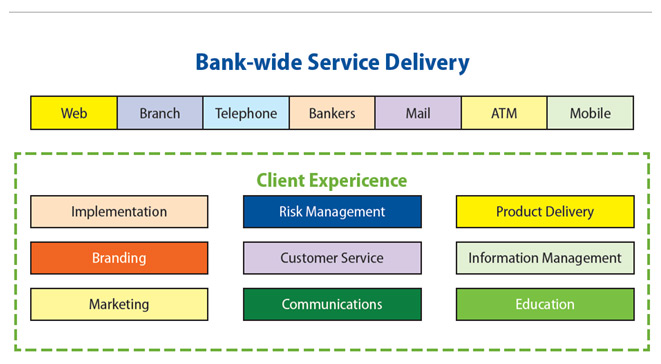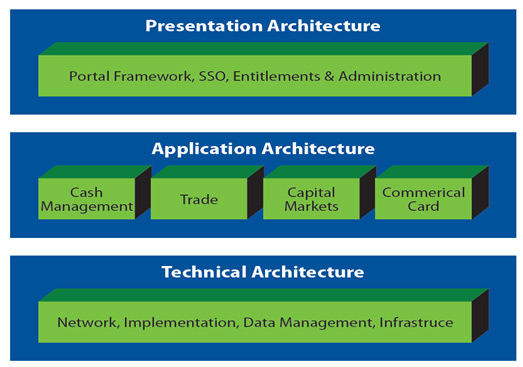
Introduction
Today's banking experience is vastly different for corporations than it has been in the past. Customer experience, rather than product functionality is a key focus for banks today. While customers can use any number of channels to access the bank, the industry is seeing more use of the web, mobile, and tablet interfaces as the lines blur between how personal and commercial users interact with the bank via the web.
Over the past decade, treasury management services have become more commoditized, pushing banks to focus on a key point of differentiation, the client experience. This focus not only enhances the banks' relationship with corporate clients, but also drives revenue and customer retention, particularly through services offered through the bank. Given these points of focus, banks can use these tangible benefits to build a business case for investment in the web portal.
In this light, the web portal has become an essential channel for both providers and corporate clients. Treasury Strategies has seen a decline in corporate requests for operational site tours, an uptick in requests for detailed demonstrations of the bank's web channel, and a higher degree of rigor in the testing of files and message integration. Corporations are seeking efficiency and are more satisfied when the online channel allows them to achieve higher efficiency. With the web portal becoming “the face of the bank,” increased investment is directed to the online channel.
In this white paper, we will discuss the full scope of the web portal and treasury services/cash management today, corporate needs and benefits, the business case for the build-out of the commercial web platform, and the future of web portal functionality.
Evolution of Treasury Services and Cash Management: Treasury 3.0
The scope of treasury services and cash management is evolving. Historically, both banks and corporations defined their relationship on a transactional basis. The bank had products that allowed corporations to complete transactions around payables, receivables, and credit. Corporations relied on the banks to ensure their transactions occurred and provided the credit needed to enhance their business operations. Today, banks look to provide solutions, and the scope has expanded to include three primary types of services and revenues:
- Liquidity Management Revenue: account services, payables/receivables/liquidity/card products, float
- Deposit Revenue: spread revenue from current accounts/operating balances and savings/short term investments
- FX Payments and Trade Revenue: FX spread generated from payment transactions, import/export letters of credit, document management and collections, credit spread
Additionally, banks are expanding their services globally to support corporate growth into emerging markets. The web portal technology is essential in this strategy — it allows subsidiaries and employees all over the world to access the same screens, information, and rely on consistent support. Today even smaller companies have a global reach, and banks must expand their services to meet the demands of this growing segment.
This evolution from products to solutions mirrors the evolution of the relationship between banks and their clients. Treasury Strategies terms this development “Treasury 3.0.” Banks have gone from accommodating clients and their transactional needs to creating comprehensive solutions and serving as an advisor to clients. The way that banks have provided these services to clients has changed over time as well. Historically, banks built up systems by functional areas of the bank, as needed. Over time, a comprehensive bank-wide treasury services and cash management system developed and continues to evolve.

Web Portal Transformation
With these changes in services and relationships comes a change in how clients interact with the bank. Historically, clients interacted with their banks by coming into a physical branch or reaching out to their relationship manager or service team on a periodic (sometimes daily) basis. This has drastically changed, and today, clients' primary method of interaction with their banks is through the web portal. This fundamental shift is due to multiple market forces. Clearly, the availability of technology is a strong force in the development of the web portal. Additionally, retail customers have increased their use of the web portal. This comfort in using technology instead of a representative at the bank branch on the retail side has spread to the commercial space. Thus, retail clientele have shaped corporations' usage of the web channel and corporations prefer to use the web channel today versus previous methods of interaction.
Corporate clients are able to use the web channel for the full scope of their relationships with their banks. This includes products and services (credit, trade, liquidity, payments, info, servicing) and also integration and interaction with the bank (servicing, implementation, training, industry knowledge).
For corporations, the web portal has increased in popularity due to the convenience and efficiency it allows. Historical pain points included issues around disparate business units and geographies that were unable to provide reliable information. Today, the web portal is critical in solving these issues for corporations. It allows corporations to have one integrated platform through which to do business around the world.
Key benefits include:
- Accurate, comprehensive data: Clients can access data for their business worldwide and know that it is correct
- Real-time information: Being able to access real-time data is a huge advantage for treasurers who are now expected to report on a real-time basis to senior management
- Customized reporting and analytics: Today, the web portal offers advanced analytics and the ability for users to customize reports as needed
- Increased efficiency: Access to this information and reporting is a huge time-saver for corporate treasury departments who, with more responsibility, are always looking to streamline processes
- More flexibility: The web portal allows corporations to go online and access their information at all times which gives them the flexibility to conduct work outside of business hours when a branch is open
- Greater insight: Banks are able to provide analytics through the web portal that give corporations fast and easy access to insight into their cash positions and liquidity
- Global integration: The web portal serves as a platform that allows banks to give their customers access to products, services, and features across the world
Corporate Online Treasury Services and Cash Management Needs
Much of banks' evolving offerings have been a reaction to corporate needs. When evaluating “Treasury 3.0” from a corporate perspective, Treasury Strategies observes that corporations' needs used to be based around data, evolving to information, and today moving to intelligence. The word “intelligence” implies that corporations are demanding functionality such as dynamic information reporting and analytics/tools to optimize cash. Also, clients expect banks to provide a broader array of solutions/information in an integrated fashion. This includes non-financial activities like electronic administration, mobile integration, security features, social networking, and customer service. All of this is more easily accessible through a web portal.
Corporations' need for intelligence converges with their liquidity management and cash pooling needs. Intelligence allows them to clearly view their liquidity position and pooling allows them to efficiently manage their cash. Intelligence is especially needed to manage global needs and the web portal's ability to deliver a global view to users all over the world is critical to corporations.
Bank Online Channel Enhancements
Banks have, and are responding to, corporate needs with advanced web portal functionality. One example is online management and reporting on pooling (physical and notional), which is the use of surplus cash balances to fund any deficits and maximize efficient use of funds. The web portal is the ideal channel for managing the flow of these funds and the administrative rules alongside. This type of online management is not only ideal for corporate clients, but helps banks to reduce back-office support costs as well. For example, eBAM, or electronic bank account management, allows clients to automatically generate documents and workflows that make the process of managing accounts more efficient.
While corporations are looking for this robust functionality, when taking a holistic view of the web channel, three other components come into play: a dynamic accessible interface, a single platform that can deliver insights and expand flexibly, and integration.
Web 2.0 functionality is frequently used to refer to a wide variety of new online functionality and user experiences. The three primary components are a dynamic, customizable user interface, a web chat, and online self-service. Banks are providing all of this functionality to address corporate needs in a single platform. The importance of integration is explored in the following section.
Bank Integration Trends
Integration is a critical theme in supporting the web channel. There are different kinds of integration: integration within bank channels, across geographic data, and between corporate technology and bank interfaces.
Banks are putting emphasis on consistency and integration across all channels of interaction with the bank. If the web portal is the “face” of the bank, the bank wants to ensure that “face” looks consistent no matter what channel of interaction a customer uses and no matter where the user is physically located when accessing the web portal (e.g., online, mobile, app, tablet, etc.).
Banks also have to ensure all systems with client data are fully integrated. If a customer goes into a branch, goes to an ATM, or accesses the web portal, they must see the exact same information regarding their accounts and services.
Additionally, banks are developing their web portal such that it integrates with clients' enterprise resource planning systems (ERP) and treasury and risk management systems (TRM). This allows corporations an even more accurate and integrated view.
Banks are taking integration a step further within their own organizations. Banks are integrating product capabilities to allow for a larger scope of service offerings. FX and payments are converging, and banks are moving towards the integration of liquidity tools (cash forecasting/ positioning, optimal concentration) with trade and post-trade solutions (exposure management/reporting). Liquidity is “king” and the integration of these tools allows corporations to fully manage their cash exposures. Furthermore, banks are looking to integrate across the customer experience — including sales, implementation/onboarding, transacting, servicing, and relationship management. Integration implies that all systems that support these groups are seamless (at least in how the client views them) and that they are able to provide consistent data to the client. Today, this is still in development at banks but is a focus, because it will allow for internal efficiencies.
Not only are banks focusing on integration with corporations and internally, they are also very interested in how outside vendors are integrated with their systems. Bank needs vary based on their size and target IT portal architecture, and vendors must offer flexible support based on the unique needs of each institution. Smaller financial institutions prefer portal-like capabilities and customization through the presentation layer through a single application vendor. However, larger banks have an integrated application and presentation layer and are looking for best-in-class vendors to “plug-in” easily.

Bank Investment in the Web Channel
Banks are significantly investing in the web channel due to its increasing importance and the fact that it is the primary interaction channel with clients. Additionally, they are focused on the global capabilities of the channel because corporate needs are complex and clients are interested in moving into emerging markets.
Treasury Strategies has observed that banks invest about 8.5% of treasury services and cash management revenue (TM fee and spread revenue) on IT, on average. A little under half of this investment (45%) is spent on discretionary spending, of which roughly half goes to the web channel and supporting infrastructure — essentially a 2% spend of annual treasury services and cash management revenue. With all the varying pressures on IT departments, this is clearly a vital part of bank strategy.
Bank Business Case
Given the bank investment in the web portal, a question arises: What benefits are identified and included as part of a business case for this investment? The web portal is an important channel of the bank but it is often hard to “sell” to internal stakeholders. The web portal has been around for only a decade and the benefits, in some cases, are difficult to quantify. Clearly, the web portal allows banks to strengthen their relationships with corporations and better solve their clients' complex needs. In addition, Treasury Strategies has observed four key tangible benefits of web portal investment to banks:
- Share of Wallet: Banks have an opportunity to increase share of wallet and market penetration. By driving more traffic to the web channel and integrating services, clients will be encouraged to use a broader and deeper array of services. If the web channel is easy to use, customers will be more likely to increase their use of products and services.
- Increased Fees: The bank has an opportunity to increase fee-based income (versus spread income) by delivering new capabilities, reports and analytics to clients. With this increase in product and service usage, the bank will see an increase in fee income.
- Reduce Back Office Costs: Banks have an opportunity to reduce back-end costs of sales, implementation, training, transacting, servicing, and relationship management. The web channel provides further opportunities for customers to self-service, driving down costs for banks. Training and transacting can be done online, versus with a bank representative, which results in further cost savings. Technology and online self-servicing have allowed banks to scale their business to the small- and medium-sized enterprises that are recognizing revenue opportunities globally, particularly in the emerging markets. Overall, the SaaS, or software as a service model can deliver the same requirements, at a lower cost to the bank.
- Change Agent: The web channel is a change agent, not just an enhancement to existing functionality. The web channel can and does transform the relationship with the corporate client by providing access and configuration of data unavailable in other channels, improving time to revenue, decreasing the volatility of revenue and balances, and ultimately changing the operating model of the bank to a more cost-effective model.
Bank Decision: Buy versus Build
When evaluating the overhaul of an online platform or component of a web platform, banks must decide whether or not to build the functionality with internal IT resources or look outside the bank and buy a solution from an outside vendor.
Today, banks have many cost pressures and are looking to focus on their core competency, banking services. Therefore, banks tend to outsource new IT projects instead of developing new functionality in-house. This is due to the increasing pressure from a variety of market challenges for banks that include increasing client sophistication, globalization, and technological developments.
- Increasing Client Sophistication
-
- Clients are demanding integrated solutions, and the historical development of platforms is no longer sustainable for banks.
- In the past, business units have built up web platforms to support clients but these have not been integrated across the bank. Bank IT departments are less equipped to staff this new product development with all the demands on the group for maintenance of systems.
- Globalization
-
- Additionally, treasury departments are being centralized in order for corporations to achieve efficiencies in their global business. Banks are challenged to build a global solution on their own.
- Technological Advances
-
- Banks must keep up with vastly evolving technological developments. Today there are a range of electronic channels and file formats that banks must support. In addition, SWIFT corporate connectivity is critical and non-bank competition is increasing.
As the industry looks to the future, the emergence of SaaS from vendors becomes increasingly important. The software is accessed as a web browser and it allows for a more efficient implementation and update process for banks. There is no need for physical deployment or testing on individual computers, and information is stored securely using cloud technology. Such a solution can not only lower all-in operating costs, but can speed time to market — a major focus of SaaS solutions is not just the outsourcing of relevant costs, but also an emphasis on improving ease of integration.
With the explosion of client requirements around the web, both functional and non-functional, corporations need a bank partner that both offers this functionality and is nimble. Banks' ability to address their clients' needs which are increasingly complex and global is challenging to do in-house, even if the bank is of a larger size. Banks, both small and large, need experienced vendors that can provide a web portal solution with a short time-to-market. Using a cost-effective vendor with expertise to build an online solution can serve as a competitive advantage for banks.
As a bank considers different vendors, factors to consider include:
- Practicality: A solution that closes current functional gaps.
- Cost: A cost comparison between different vendors (in conjunction with other factors) is important, but it's important to look at all-in costs, including support and ongoing development and maintenance.
- Single sign-on: A single, scalable platform that can support a diverse customer base of high-end commercial clients as well as retail and small business clients.
- Platform architecture: Architecture aligns with the future state of the web platform. Banks may want the vendor to provide the portal architecture or, at minimum, may want the vendor to effectively integrate into the bank's target portal architecture.
- User interface: A cutting-edge delivery and dynamic user interface positions banks on the forefront of online banking technology and conveys to clients that the bank is investing in its solution set.
- Innovation: Next generation web functionality includes intuitive user-driven customization and mobile/other channel integration.
- Viability: A vendor should have the financial strength to remain strong so that it can support ongoing development of solution architecture and functionality.
Conclusion
Banks need to continue to address the complex needs of their corporations and need to do so through the most cost effective and client-centric channel — the web. The evolution of the web portal and the deepened relationship between corporations and their banking providers is here to stay. Corporations find benefits in an interactive web portal with reliable information and self servicing, and banking providers are investing significantly to meet those demands through a cost-effective platform, SaaS.
As a bank looks to move forward with investment, key considerations include:
- Define Bank Strategy of Differentiation
-
- Bank needs to decide how to differentiate its web portal and ensure that all channels are consistent in format and capabilities
- Identify Scope of Online Solution:
-
- Scope of the solution will be determined by the bank's strategy of differentiation
- Assess Key Functional Areas to Improve/Grow
-
- Compare current capabilities to define scope and identify areas that need development
- Prioritize Investment and Sequence Build-Out:
-
- Prioritize necessary development and contract third party if decision is to “buy”
- Develop the Business Case for Investment
-
- Document key drivers that will increase revenue and retention with the online solution
- Gather Executive and Organizational Support
- Drive Go-To-Market Strategy
Complete your profile to continue reading and get FREE access to Treasury & Risk, part of your ALM digital membership.
Your access to unlimited Treasury & Risk content isn’t changing.
Once you are an ALM digital member, you’ll receive:
- Thought leadership on regulatory changes, economic trends, corporate success stories, and tactical solutions for treasurers, CFOs, risk managers, controllers, and other finance professionals
- Informative weekly newsletter featuring news, analysis, real-world case studies, and other critical content
- Educational webcasts, white papers, and ebooks from industry thought leaders
- Critical coverage of the employee benefits and financial advisory markets on our other ALM sites, PropertyCasualty360 and ThinkAdvisor
Already have an account? Sign In Now
*May exclude premium content© 2025 ALM Global, LLC, All Rights Reserved. Request academic re-use from www.copyright.com. All other uses, submit a request to [email protected]. For more information visit Asset & Logo Licensing.





